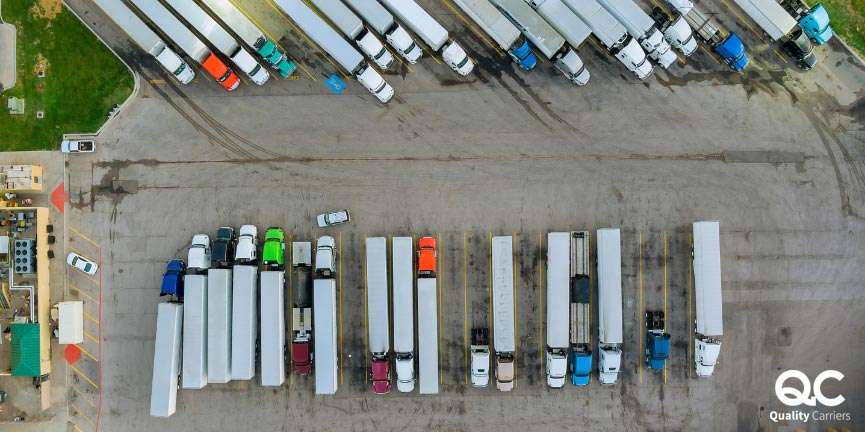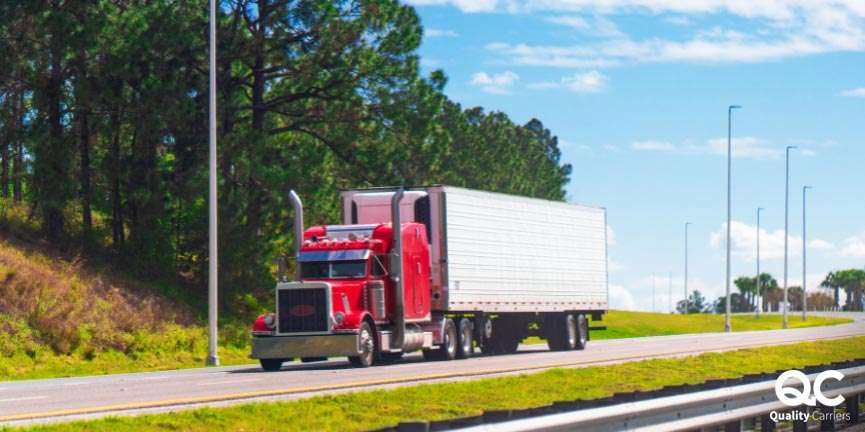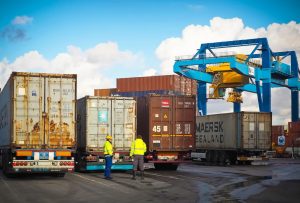Despite what many individuals may think, intermodal transportation is not a new phenomenon. The idea of using different modes of transportation to move goods and services has been around for a while but is taking on a new meaning and importance in the modern era.
Intermodal is a portmanteau word from “inter” and “modal” that can mean different things. In Europe, the phrase stands for multi-modal transportation, which means more than one mode of transport. Intermodal transportation in the U.S. is known as the movement of cargo components by trucks or trains, also known as intermodalism. It is a trade term in logistics, shipment, and transportation management.
Intermodal transportation involves multiple modes of transportation during a single journey. It refers to using two or more modes of transport for cargo movements such as road, rail or waterway. It generally means that a single shipment is picked up and delivered by different modes of transportation, sometimes consecutively.
A key advantage of intermodal shipping is that it simplifies the tracking of shipments from their origin at the manufacturer or shipper’s warehouse through delivery at the customer’s business or retail point-of-sale location.
History of Intermodal Transportation
Intermodal transportation has been around for centuries, but the term was coined in the 1960s.
Before Intermodal Transportation, there was no such thing as a cargo container. Instead, the cargo was loaded onto ships in large wooden crates. These crates were often stacked on top of each other and then covered with netting to keep them from shifting during transport. This made loading and unloading very time-consuming and expensive for shipping companies and the people who owned the cargo being shipped.
Development of Containers
The first containers were wooden boxes used by train companies as early as the 1920s. They were designed to carry different types of cargo efficiently, but they needed to be standardized because they did not work well with other modes of transportation like trucks or ships.
By the 1940s, railroads started using steel boxes with lids that could be locked shut and stacked together when empty or filled with cargo. These containers could be loaded onto a ship or truck for shipping and unloaded quickly when needed again because they had standardized sizes and weights.
The 1960’s: Intermodal Shipping becomes popular by the sea
The 1960s saw the introduction of intermodal transport and containerization, dramatically changing how goods were transported worldwide.
Containerization allowed for more efficient loading and unloading of cargo ships. This meant that cargo could be carried in standardized containers and easily transferred between ships, trains and trucks. Before containerization, each piece of cargo had to be unloaded from one ship and loaded onto another ship at a port. This process was very time consuming and expensive for both shippers and receivers. Using containers made it much easier to move goods around the world. The result was a dramatic increase in efficiency for both companies and consumers.
The 1980’s: Development of Rail Intermodal freight Transportation
The railroad has been the backbone of America’s transportation system since the late 19th century. Railroads have helped shape America’s landscape, connecting people and communities across the country.
The railroads were instrumental in developing intermodal freight transportation, which was a step toward improving efficiency in freight shipping.
The 1980s saw the development of rail intermodal freight transportation, made possible by technological advances, such as computerized routing and scheduling systems, which reduced costs and allowed for more efficient movement of goods. Intermodal shipping made it possible to transport goods in containers that could be easily transferred between rail, truck, ship and plane without being unloaded.

Today: Development of Intermodal Freight Shipping Ramps
With the rise of intermodal freight shipping, there has been a parallel increase in the number of development projects for intermodal freight shipping ramps.
Intermodal freight shipping ramps are essential pieces of infrastructure that allow for the safe and efficient handling of freight containers. They also provide access to and from rail lines, highways, and airports.
The growth in the use of intermodal freight shipping has led to increased demand for these facilities. In many cases, they are added onto existing infrastructure where they can be integrated into existing systems to improve efficiency and reduce costs.
Tracking and Inventory
Tracking and inventory systems have evolved but have always been an essential component of intermodal transportation. These days, they are more sophisticated than ever before.
Then
The intermodal transportation tracking system was first introduced in the early 1900s to keep track of shipments. Before this technology was available, shipments were tracked manually using paper records.
Now
Intermodal transportation tracking has become much easier with today’s technology. Many companies are using software for tracking and inventory. This software monitors the status of goods shipped across multiple transportation modes.
The software allows companies to track their goods in real-time, so they know exactly where their shipments are at any given moment. This information allows companies to plan ahead for when the goods will arrive at their destination so their customers can pick them up promptly.
Benefits of Intermodal Transportation
Intermodal shipments are often part of the supply chain for businesses and industries.
The benefits of intermodal transportation include the following:
Cost Effective
The cost of transporting goods by truck can be expensive. The more miles you travel, the more fuel you consume and the higher your costs. Intermodal transportation allows you to use a single carrier for multiple modes of transportation, which helps reduce costs by avoiding double handling and dedicated equipment. The shipper pays once for all shipments and receives fast delivery at competitive rates with no hidden fees or surcharges.
Sustainability
Intermodal transportation is an environment-friendly method of transporting goods because it uses fewer resources than other modes. It also reduces pollution as fewer vehicles are used in this system, reducing emissions from vehicles into the environment. Intermodal transport offers several environmental benefits, such as a lower carbon footprint, reduced pollution and fuel consumption etc.
Reliable Capacity
Intermodal transportation enables you to take advantage of multiple modes without worrying about having enough room on each mode. The same goes for hauling smaller shipments for which there may not be enough space in a single vehicle but where combining them creates enough capacity for a larger payload.
Increase Shipment Safety
One of the main benefits of intermodal transportation is that it increases safety. Intermodal transportation is safer than other types of transportation because it does not rely on one mode of travel. Your shipment may be transported by truck, ship, and train. If something were to happen during the journey that causes your truck to break down or your ship to sink, then you would still have two other modes available for use so that you can deliver your shipment safely without risking any accidents or delays in delivery time.
Shipment Visibility
Intermodal shipping provides a seamless shipping experience for the customer by providing visibility into the entire process. With intermodal transportation, customers can track their shipments using GPS tracking systems, allowing them to know precisely where their goods are at all times.
Modes of Transportation
There are four primary modes of intermodal transportation: rail, container ship, aircraft and truck. Each of these modes has its advantages and disadvantages, but all of them can be leveraged to transport goods from one place to another.
Rail Intermodal
Rail intermodal is a system of transporting goods by railroads in specially designed containers or trailers. This service is a competitive alternative to truckload and less-than-truckload (LTL) services. The main advantage of rail intermodal over trucking is reduced damage and faster transit times.
Rail intermodal is the fastest-growing U.S. freight transportation industry segment, with volumes increasing annually at more than 6 percent per year since 1990. Railroads offer numerous advantages over trucks for freight movements: lower cost per mile, lower damage rates and increased flexibility for next-day service. In addition, rail transportation provides an environmentally friendly means of moving goods from one location to another without damage from inclement weather conditions such as rain, snow and ice storms that can delay highway traffic.
Container Ship
A container ship is a vessel that transports cargo in standardized intermodal containers. It uses lifted containers to move large volumes of freight from ocean ports to destinations worldwide.
Container ships are the largest type of commercial ship, typically 300 m (1000 ft) long and up to 58 m (190 ft) wide. They can carry from 4,000 to 15,000 individual containers. Container ships usually have specialized hulls and equipment, such as massive cranes and side-tipping mechanisms, making them unique among other types of ships.
Containers have become the dominant form of international freight transport since the 1950s. They are used by virtually all types of trade, from bulk commodities such as coal and ores to manufactured products such as electronics and apparel.
Aircraft
Air transportation is a primary method of intermodal transportation, and it is used in conjunction with other modes of transportation such as rail, road, water and pipeline.
The use of aircraft as an intermodal transportation method has become more prevalent in recent years. The major airlines have their cargo departments and operate small fleets of dedicated cargo aircraft. These aircraft can be leased out by airlines or hired by freight forwarders for specific shipments.
Truck
Truck transportation is a form of intermodal transportation that uses trucks to move goods.
Trucks work well for transporting goods over long distances, mainly when the distance is too far for the cargo to be transported by rail or waterway. Trucks can also work in emergencies where other modes are unavailable or blocked due to an accident, landslides or other natural disasters.

What is the Environmental Impact of Intermodal Transportation?
Intermodal shipping does have an environmental impact, but it is beneficial for the environment versus relying on just one mode. By combining rail transport with intermodal trucking, less fuel is consumed overall than if either method was used individually. This reduces emissions, which results in less pollution being released into the atmosphere.
Conclusion
Put simply, it is the movement of goods across modes of transport, such as land, sea, air or rail. Intermodal transportation’s diversity removes supply chain redundancies and facilitates seamless transfers across modes, making it vital. And that’s how it can help your business.
FAQs
It depends because there are variables involved in the cost of shipping goods by truck and rail that it’s difficult to determine exactly how much you will save using intermodal transportation. Some companies have reduced their costs by as much as 30 percent, while others have seen increases of 20 percent or more.
Yes! Intermodal service is reliable and safe. It is one of the most reliable options for shipping freight around the world. The cargo arrives at its destination on time and intact every time.
Intermodal shipping companies have different rules regarding the maximum weight of cargo that can be shipped. Some companies allow you to load up to 40,000 pounds while others may allow you to load up to 80,000 pounds. The maximum weight allowed is dependent on the type of equipment and how much it can handle.
Yes, there are some items that cannot be transported due to safety reasons. These include alcohol and tobacco products, perishable food items, hazardous materials, illegal substances and weapons.









